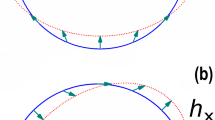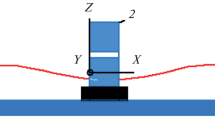Abstract
An experiment to measure the speed of gravity is being planned. For this purpose, a numerical method was developed for the optimization of a composite quadrupole mass at high-speed rotation. The optimization calculations aim to obtain a quadrupole mass which must generate a periodic gravitational signal of 3200 Hz with maximum amplitude, taking into account its geometric features and the mechanical properties of the component materials. Considering the gravitational wave detector Mario Schenberg as the signal receiving device, an estimate was obtained in which the largest emitter-detector distance for detecting the gravitational signal is between the orders of magnitude \(10^1\) and \(10^2\) m. A simplified modeling of the emitter-detector system indicates that the gravitational signal amplitude h decreases approximately proportional to \(r^{-5}\), where r is the emitter-detector distance. The results obtained in this work serve as reference for more detailed numerical simulations in the future.









Similar content being viewed by others
Abbreviations
- h :
-
Gravitational signal amplitude
- r :
-
Emitter-detector distance
- M :
-
One of the two masses of the emitter (simplified modeling)
- m :
-
One of the two masses of the detector (simplified modeling)
- \(m_1\), \(m_2\) :
-
Masses of the detector (\(m = m_1 = m_2\), simplified modeling)
- a :
-
Rotation radius of the mass M
- b :
-
Natural length of the detector spring (simplified modeling)
- \(\omega \) :
-
Rotation angular frequency
- f :
-
Rotation frequency
- G :
-
Gravitational constant
- \(F_{1x}, F_{2x}\) :
-
Gravitational forces acting on the masses \(m_1\) and \(m_2\), respectively, on the x-axis
- \(\mu \) :
-
Reduced mass of the detector system (simplified modeling)
- \(F_x^{\mathrm {int}}\) :
-
Sum of internal forces of the detector system (simplified modeling)
- \(\alpha \) :
-
Damping coefficient
- k :
-
Spring elastic constant
- \(F_{\mathrm {ext}}\) :
-
External force acting on the detector
- \(F_{\mathrm {var}}\) :
-
Time-dependent external force acting on the detector
- \(\omega _{0}\) :
-
Resonance frequency of the detector
- \(\gamma \) :
-
\(=\, \alpha /m\)
- \(\beta \) :
-
Given in Eq. (14)
- \({\Delta }x\) :
-
Length variation of the detector
- Q :
-
Mechanical quality factor of the detector
- p, l, d, q, s :
-
Geometric variables of the quadrupole mass
- \(F_T\) :
-
Centrifugal force on the center of mass of one of the symmetrical halves of the quadrupole mass relating to the xz plane
- \(M_{\mathrm {half}}\) :
-
One half mass of the quadrupole system
- \(R_{\mathrm {c.m.}}\) :
-
Rotation radius of the center of mass of \(M_{\mathrm {half}}\)
- \(F_{y\,{\mathrm {steel}}}\) :
-
Force acting perpendicularly to the xz plane on the steel component of the quadrupole mass
- \(F_{y\,{\mathrm {carbon}}}\) :
-
Sum of the forces acting perpendicularly to the xz plane on the carbon fiber components of the quadrupole mass
- \(\rho _{\mathrm {steel}}\) :
-
Density of Maraging steel 2800
- \(\rho _{\mathrm {c\,th}}\) :
-
Average density of carbon fiber (thread) + epoxy composite
- \(\rho _{\mathrm {c\,lam}}\) :
-
Average density of carbon fiber (laminate) + epoxy composite
- \(\sigma _{\mathrm {steel}}\) :
-
Admissible tensile stress for Maraging Steel 2800
- \(E_{\mathrm {steel}}\) :
-
Young’s modulus of Maraging Steel 2800
- \(E_c\) :
-
Young’s modulus of carbon fiber (thread or laminate) + epoxy composite
- \(r_{\mathrm {hole}}\) :
-
Central hole radius of the quadrupole mass
- \(\varepsilon _y\) :
-
Strain that occurs perpendicularly and in the vicinity of the xz plane
- v, u, w :
-
Variables used for the deduction of Eq. (25)
- R :
-
Cross-sectional radius of the quadrupole mass
- dA :
-
Area element
- dm :
-
Mass element
- \(\rho _{\mathrm {v \, c \, lam}}\) :
-
Virtual density of the carbon fiber laminate component
- \(\rho _{\mathrm {v \, c \, th}}\) :
-
Virtual density of the carbon fiber (thread) component
- \(\rho _{\mathrm {v \, steel}}\) :
-
Virtual density of the steel component
- \(S_G\) :
-
Gravitational signal intensity
- \(S_{G\,\mathrm {max}}\) :
-
Signal oscillation amplitude
References
Abbott BP et al, LIGO Scientific Collaboration and Virgo Collaboration (2016) Observation of gravitational waves from a binary black hole merger. Phys Rev Lett 116:061102
Abbott BP et al, LIGO Scientific Collaboration and Virgo Collaboration (2016) GW151226: observation of gravitational waves from a 22-solar-mass binary black hole coalescence. Phys Rev Lett 116:241103
Abbott BP et al, LIGO Scientific and Virgo Collaboration (2017) GW170104: observation of a 50-solar-mass binary black hole coalescence at redshift 0.2. Phys Rev Lett 118:221101
Abbott BP et al, LIGO Scientific Collaboration and Virgo Collaboration (2017) GW170817: observation of gravitational waves from a binary neutron star inspiral. Phys Rev Lett 119:161101
Paranjape MB (2013) A proposal to measure the speed of gravity. Can J Phys 91:455. arXiv:1208.2293 (expanded version)
Deasy H (2014) Measuring the speed of gravity and/or the Coulomb force. J Space Explor 3(2):FP129–FP138
Hartle JB (2003) Gravity: an introduction to Einstein’s general relativity. Addison-Wesley, Boston, p 332 ISBN 981-02-2749-3
Lorentz HA (1900) Considerations on gravitation. Proc Acad Amsterdam 2:559–574
Damour T, Taylor JH (1991) On the orbital period change of the binary pulsar PSR \(1913+16\). ApJ 366:501–511
Stairs IH, Arzoumanian Z, Camilo F, Lyne AG, Nice DJ, Taylor JH, Thorsett SE, Wolszczan A (1998) Measurement of relativistic orbital decay in the PSR \(\text{ B }1534+12\) binary system. ApJ 505:352–357
Fomalont EB, Kopeikin SM (2003) The measurement of the light deflection from Jupiter: experimental results. ApJ 598:704
Samuel S (2004) On the speed of gravity and the Jupiter/quasar measurement. Int J Mod Phys D 13:1753
Carlip S (2004) Model-dependence of Shapiro time delay and the speed of gravity/speed of light controversy. Class Quantum Grav 21:3803–3812
Castelvecchi D, Witze A (2016) Einstein’s gravitational waves found at last. Nat News. https://doi.org/10.1038/nature.2016.19361
Frajuca C, Ribeiro KL, Andrade LA, Aguiar OD, Magalhães NS, Marinho RM Jr (2004) A noise model for the Brazilian gravitational wave detector Mario Schenberg. Class Quantum Grav 21:S1107–S1112
Frajuca C, Ribeiro KL, Andrade LA, Velloso WF Jr, Melo JL, Aguiar OD, Magalhães NS (2002) Transducers for the Brazilian gravitational wave detector Mario Schenberg. Class Quantum Grav 19:1961–1966
Johnson WW, Merkowitz SM (1993) Truncated icosahedral gravitational wave antenna. Phys Rev Lett 70:2367
Johnson WW, Merkowitz SM (1997) Techniques for detecting gravitational waves with a spherical antenna. Phys Rev D 56:7513
Magalhães NS, Aguiar OD, Johnson WW, Frajuca C (1997) Possible resonator configurations for the spherical gravitational wave antenna. Gen Relat Grav 29:1511–1525
Magalhães NS, Johnson WW, Frajuca C, Aguiar OD (1995) Determination of astrophysical parameters from the spherical gravitational wave detector data. MNRAS 274:670–678
Magalhães NS, Jonhson WW, Frajuca C, Aguiar OD (1997) A geometric method for location of gravitational wave sources. ApJ 475:462
Bortoli FS, Frajuca C, Souza ST, de Waard A, Magalhães NS, Aguiar OD (2016) On the massive antenna suspension system in the Brazilian gravitational wave detector SCHENBERG. Braz J Phys 46:308–315
Souza ST (2012) O detector de ondas gravitacionais Mario Schenberg: uma antena esférica criogênica com transdutores paramétricos de cavidade fechada. Ph.D. thesis, University of São Paulo (USP), p 3
Frajuca C, Bortoli FS, Magalhães NS (2006) Studying a new shape for mechanical impedance matchers in Mario Schenberg transducers. J Phys Conf Ser 32:319–322
Frajuca C, Bortoli FS, Magalhães NS (2005) Resonant transducers for spherical gravitational wave detectors. Braz J Phys 35(4B):1201–1203
Misner CW, Thorne KS, Wheeler JA (1973) Gravitation. WH Freeman and Company, San Francisco Chapter 37
Ju L, Blair DG, Zhao C (2000) Detection of gravitational waves. Rep Prog Phys 63:1317–1427
de Rue J (1996) On the normal modes of freely vibrating elastic objects of various shapes. MSc thesis, University of Amsterdam, Chapter 4
Symon KR (1971) Mechanics, 3rd edn. Addison-Wesley Publishing Company, Inc, Reading
Hibbeler RC (2010) Engineering mechanics: statics, 12th edn. Pearson Education, Inc, Upper Saddle River
MatWeb-The Online Materials Information Resource. http://www.matweb.com/
\({\text{Texiglass}}^{\circledR}\) (2014) Painel Náutico. Data presented at FEIPLAR 2014—International Fair and Congress of Composites, Polyurethane and Engineering Plastics (São Paulo, Brazil). http://feiplar.com.br/_site2014/portugues/materiais/palestras/nautico/Texiglass.pdf. Retrieved 26 June 2017
Minus M, Kumar S (2005) The processing, properties, and structure of carbon fibers. JOM 57:52–58
Machado MG (2004) Estudo Experimental da Ductilidade de Vigas em Concreto Armado Reforçadas à Flexão Utilizando Compósitos com Tecido de Fibras de Carbono. MSc thesis, PUC-Rio (Brazil), Chapter 2
Solinas G (2012) Reforços para Náutica. Data of Texiglass\(^{\circledR}\) presented at FEIPLAR 2012 - International Fair and Congress of Composites, Polyurethane and Engineering Plastics (São Paulo, Brazil). http://www.tecnologiademateriais.com.br/mt/2012/cobertura_paineis/nautico/apresentacoes/Texiglass.pdf. Retrieved 26 June 2017
Ohue Y, Matsumoto K (2007) Sliding-rolling contact fatigue and wear of maraging steel roller with ion-nitriding and fine particle shot-peening. Wear 263(1–6):782–789
GNU Fortran website: https://gcc.gnu.org/fortran/
Melo JL (2002) Sistemas de Isolamento Vibracional e de Acoplamento Antena-transdutores para o Protótipo de um Detector de Ondas Gravitacionais. Ph.D. thesis, INPE (Brazil), p 7
Acknowledgements
M. A. Souza receives financial support (postdoctoral fellowship) from Coordenação de Aperfeiçoamento de Pessoal de Nível Superior (CAPES). C. Frajuca thanks research grant #2013/26258-4 from Fundação de Amparo à Pesquisa do Estado de São Paulo (FAPESP).
Author information
Authors and Affiliations
Corresponding author
Ethics declarations
Conflict of interest
The authors declare that they have no conflict of interest.
Additional information
Technical Editor: Paulo de Tarso Rocha de Mendonça.
Appendix: Justification for Eq. (25)
Appendix: Justification for Eq. (25)
This appendix shows the arguments that result in Eq. (25). This equation is used to estimate the deformation suffered by the carbon fiber components in the vicinity of the xz plane. Initially, two approximate conditions are assumed:
-
The densities \(\rho _{\mathrm {c \, th}}\) and \(\rho _{\mathrm {c \, lam}}\) are treated as a single density \(\rho \) for the carbon fiber components. This argument can be seen as reasonable, since \(\rho _{\mathrm {c \, lam}} / \rho _{\mathrm {c \, th}} \approx 0.95\). This approximation is used exclusively in the deduction of Eq. (25);
-
The strain \(\varepsilon _y\), which occurs perpendicularly and in the vicinity of the xz plane, is a continuous function of the length v (indicated in Fig. 5), even at the interfaces of the system components.
The following arguments are based on Fig. 5, which represents the cross section of a homogeneous cylindrical object of radius R. Such a object, idealized only for the deduction of Eq. (25), is used for the simplified treatment of the region composed of carbon fiber (thread or laminate) + epoxy, taking into account that the object has length s along the z-axis as well as the quadrupole mass (see Fig. 3).
We start the deduction by calculating the centrifugal force \(df_c\) (in modulus) that acts on the mass element dm:
The component of \(df_c\) in the y-axis is given by
With Eq. (36), we determine the force \(dF_y\), which acts in the y-direction on the xz plane, due to the sum of the forces \(df_{c \, y}\) applied along the vertical mass (v.m.) with infinitesimal thickness dv (in light blue in Fig. 5). It is given by
Defining the volumetric density
the mass element dm is given by
Applying Eq. (39) in Eq. (37), \(dF_y\) is given by
Remembering that the cylinder has radius R, the integration limits \(\textit{w}_1\) and \(\textit{w}_2\) are
Applying these limits in Eq. (40), we have
The area element dA, below the highlighted vertical mass and on the xz plane, is given by \(dA = s \, dv\). Then Eq. (42) can be rewritten as
Therefore, the tensile stress \(\sigma _y\), which acts in the y-direction on the area dA, is given by
The strain \(\varepsilon _y\), which occurs perpendicularly and in the vicinity of the area dA, is given by
where E is the Young’s modulus of the material under study. Eq. (45) shows that \(\varepsilon _{y}\) is proportional to \((R^{2}-v^{2})\), that is,
where c is a coefficient to be determined so that the function \(\varepsilon _y(v)\) is continuous along the xz plane.
Rights and permissions
About this article
Cite this article
Frajuca, C., Souza, M.A., Coppedé, D. et al. Optimization of a composite quadrupole mass at high-speed rotation. J Braz. Soc. Mech. Sci. Eng. 40, 319 (2018). https://doi.org/10.1007/s40430-018-1239-9
Received:
Accepted:
Published:
DOI: https://doi.org/10.1007/s40430-018-1239-9




